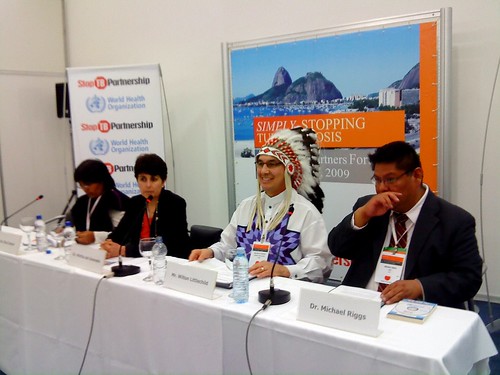Neglect of TB control among indigenous communities unethical
The need to include indigenous people in the Global Plan to Stop TB was echoed by many participants at the 3rd Stop TB Partners' Forum in Rio de Janeiro, Brazil (23-25 March 2009).
"We demand inclusion of indigenous peoples in the Global Plan to Stop TB strategy and have launched a strategic framework aimed at addressing tuberculosis among indigenous peoples. The Stop TB Strategy builds on the successes of directly observed treatment shortcourse (DOTS) while also explicitly addressing the key challenges facing TB. Its goal is to dramatically reduce the global burden of tuberculosis by 2015" said Wilton Littlechild, Regional Chief, Assembly of First Nations.
There are approximately 370 million indigenous peoples globally in more than 70 countries. Although programmes have been designed to combat TB, indigenous populations globally have been left out of such efforts due to cultural barriers, language differences, geographic remoteness, and economic disadvantage. TB rates among indigenous people are consistently higher than general public. During the five year period 2002-2006, the first nations TB rate was 29 times higher than others born in Canada - for the Inuit, it was 90 times higher. Pacific islanders and Maoris are 10 times more likely to contract TB than other people living in New Zealand. In Kalaallit Nunaat, Greenland, residents have a risk rate more than 45 times greater than Danish born citizens.
"These challenges will not be easily met - but they can be met by ensuring indigenous peoples are true partners in global TB control. We have a comprehensive and achievable plan to stop indigenous TB globally, but to realize our goal we need support" said Chief Littlechild.
Indigenous people have a consistent pattern of health inequality across a variety of jurisdictions from resource poor to the resource rich. Indigenous health inequalities are multi-faceted, and are both social and political in nature.
"Indigenous leaders will continue to work with the United Nations Permanent Forum on indigenous issues, the World Health Organization (WHO) and the Stop TB Partnership in addressing indigenous TB globally" further added Chief Littlechild.
Highlighting the problem of TB treatment default and risk of developing drug-resistant forms of TB in indigenous people, Chief Littlechild said that "we wish to establish a secretariat to collect data of TB programmes in indigenous communities. Due to a broad range of reasons, indigenous people aren’t able to access TB-related treatment and care services and if they are, then they are more likely to default, increasing the risk to develop drug resistance" said Chief Littlechild. With the High Level Ministerial meeting on multi- and extensively- drug-resistant TB (M/XDR-TB) going to open in Beijing, China (1-3 April 2009) later this week, it is indeed a clear message from indigenous communities for their Health Ministers to commit to responding to their specific issues regarding TB control.
In response to another question, Chief Littlechild said that "human rights based approach calls for genuine partnership and indigenous communities can be part of the solution."
The inequities faced by indigenous communities are much severe than in general population. "Countries like Canada report that poverty has gone down but poverty in indigenous communities has gone up. In prisons too there are a significant number of indigenous communities. There are host of other life conditions that put these people at an elevated risk of infectious diseases like TB - overcrowded housing and lack of access to safe drinking water are just few of those challenges" said Chief Littlechild.
The strategic framework to control TB among indigenous populations was developed through consultations with indigenous leaders, TB experts and health advocates from over 60 countries. It is designed to take an indigenous approach that links the right to health, education, housing, employment, and dignity. It is based on equality of opportunity to the highest level of health attainable world wide. It will serve as a tool to build a social movement to raise awareness of indigenous TB, to develop targets and messages, to pilot interventions and to monitor TB trends among indigenous peoples. An important component to this framework calls upon indigenous peoples to demand access to TB prevention and treatment measures in their communities.
- Bobby Ramakant




No comments:
Post a Comment